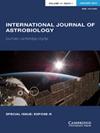氧化锆纳米粒子与核糖核苷酸相互作用及其在化学进化中作用的益生元研究
IF 1
4区 物理与天体物理
Q3 ASTRONOMY & ASTROPHYSICS
引用次数: 0
摘要
摘要研究生物分子与无机化合物(主要是矿物表面)的相互作用,对于确定它们在化学进化和生命起源中的作用具有重要意义。金属氧化物是地球和类地行星的主要成分。因此,研究生物分子与这些矿物的相互作用是研究不同行星上生命出现的关注点。氧化锆是地壳中存在的金属氧化物之一,因为它是在海滩和河床等沙质地区发现的几种岩石的一部分,例如巴德莱岩的卵石。已经研究了不同的金属氧化物在化学进化中的作用,但没有关于氧化锆在化学进化和生命起源中的作用的研究报告。因此,研究了核糖核酸成分5′-CMP(胞苷一磷酸)、5′-UMP(尿苷一磷酸),5′-GMP(鸟苷单磷酸)和5′-AMP(腺苷一磷酸)与氧化锆的相互作用。利用振动样品磁强计、X射线衍射仪、扫描电子显微镜和透射电子显微镜对合成的氧化锆颗粒进行了表征。氧化锆颗粒在14至27纳米的纳米范围内。氧化锆与核糖核酸成分的相互作用在5×10−5–300×10−5M的浓度范围内进行。在三种介质中进行了相互作用研究;酸性(pH 4.0)、中性(pH 7.0)和碱性(pH 9.0)。在中性pH下,观察到最大的相互作用。氧化锆与5′-UMP和5′-CMP的相互作用分别为49.45%和67.98%,而与其他化合物的相互作用介于两者之间。相互作用研究本质上是郎格的。计算Xm和KL值。对核糖核苷酸、金属氧化物和核糖核苷酸-金属氧化物加合物进行了红外光谱研究,以找出相互作用位点。观察到核糖核苷酸的氮碱基和磷酸部分与金属氧化物的正电荷表面相互作用。并用扫描电镜对其吸附性能进行了研究。本研究的结果支持氧化锆在原始海洋中浓缩稀释水溶液中的有机分子方面的重要作用。本文章由计算机程序翻译,如有差异,请以英文原文为准。
Prebiotic studies on the interaction of zirconia nanoparticles and ribose nucleotides and their role in chemical evolution
Abstract Studies on the interaction of biomolecules with inorganic compounds, mainly mineral surfaces, are of great concern in identifying their role in chemical evolution and origins of life. Metal oxides are the major constituents of earth and earth-like planets. Hence, studies on the interaction of biomolecules with these minerals are the point of concern for the study of the emergence of life on different planets. Zirconium oxide is one of the metal oxides present in earth's crust as it is a part of several types of rocks found in sandy areas such as beaches and riverbeds, e.g. pebbles of baddeleyite. Different metal oxides have been studied for their role in chemical evolution but no studies have been reported about the role of zirconium oxide in chemical evolution and origins of life. Therefore, studies were carried out on the interaction of ribonucleic acid constituents, 5′-CMP (cytidine monophosphate), 5′-UMP (uridine monophosphate), 5′-GMP (guanosine monophosphate) and 5′-AMP (adenosine monophosphate), with zirconium oxide. Synthesized zirconium oxide particles were characterized by using vibrating sample magnetometer, X-Ray Diffraction (XRD), scanning electron microscopy (SEM) and transmission electron microscopy. Zirconia particles were in the nanometre range, from 14 to 27 nm. The interaction of zirconium oxide with ribonucleic acid constituents was performed in the concentration range of 5 × 10−5–300 × 10−5 M. Interaction studies were carried out in three mediums; acidic (pH 4.0), neutral (pH 7.0) and basic (pH 9.0). At neutral pH, maximum interaction was observed. The interaction of zirconium oxide with 5′-UMP was 49.45% and with 5′-CMP 67.98%, while with others it was in between. Interaction studies were Langmurian in nature. Xm and KL values were calculated. Infrared spectral studies of ribonucleotides, metal oxide and ribonucleotide–metal oxide adducts were carried out to find out the interactive sites. It was observed that the nitrogen base and phosphate moiety of ribonucleotides interact with the positive charge surface of metal oxide. SEM was also carried out to study the adsorption. The results of the present study favour the important role of zirconium oxide in concentrating the organic molecules from their dilute aqueous solutions in primeval seas.
求助全文
通过发布文献求助,成功后即可免费获取论文全文。
去求助
来源期刊

International Journal of Astrobiology
地学天文-地球科学综合
CiteScore
3.70
自引率
11.80%
发文量
45
审稿时长
>12 weeks
期刊介绍:
International Journal of Astrobiology is the peer-reviewed forum for practitioners in this exciting interdisciplinary field. Coverage includes cosmic prebiotic chemistry, planetary evolution, the search for planetary systems and habitable zones, extremophile biology and experimental simulation of extraterrestrial environments, Mars as an abode of life, life detection in our solar system and beyond, the search for extraterrestrial intelligence, the history of the science of astrobiology, as well as societal and educational aspects of astrobiology. Occasionally an issue of the journal is devoted to the keynote plenary research papers from an international meeting. A notable feature of the journal is the global distribution of its authors.
 求助内容:
求助内容: 应助结果提醒方式:
应助结果提醒方式:


